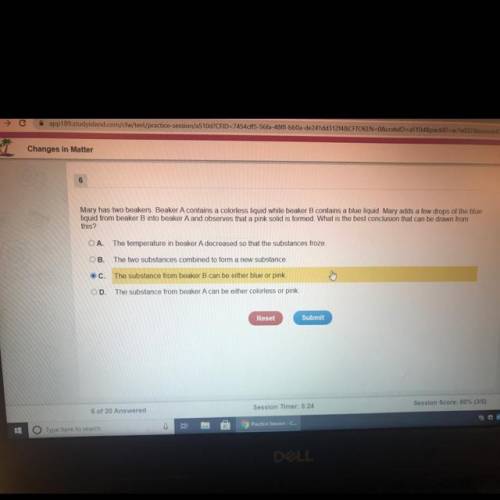Changes in Matter
6
Mary has two beakers. Beaker A contains a colorless liquid while beaker B...

Chemistry, 05.11.2020 03:10 JamesLachoneus
Changes in Matter
6
Mary has two beakers. Beaker A contains a colorless liquid while beaker B contains a blue liquid. Mary adds a few drops of the blue
liquid from beaker B into beaker A and observes that a pink solid is formed. What is the best conclusion that can be drawn from
this?
OA.
The temperature in beaker A decreased so that the substances froze.
ОВ.
The two substances combined to form a new substance.
OC
The substance from beaker B can be either blue or pink
OD
The substance from beaker A can be either colorless or pink.
Reset
Submit


Answers: 1
Another question on Chemistry


Chemistry, 22.06.2019 09:30
The chart shows the bid provided by four contractors to complete a job. which contractor is the most cost-effective?
Answers: 3

Chemistry, 22.06.2019 10:00
How many mmols of tris-hcl are there in 100 ml of a 100 mm tris-hcl buffer solution at ph 8.1? note that the 100 mm refers to the sum of tris and tris-hcl concentrations?
Answers: 3

Chemistry, 22.06.2019 18:00
Hydrogenation reactions, in which h2 and an "unsaturated" organic compound combine, are used in the food, fuel, and polymer industries. in the simplest case, ethene (c2h4) and h2 form ethane (c2h6). if 140 kj is given off per mole of c2h4 reacting, how much heat (in mj) is released when 12 kg of c2h6 forms?
Answers: 2
You know the right answer?
Questions

Biology, 03.08.2019 14:40

Mathematics, 03.08.2019 14:40

Mathematics, 03.08.2019 14:40

Mathematics, 03.08.2019 14:40

History, 03.08.2019 14:40




Mathematics, 03.08.2019 14:40





Mathematics, 03.08.2019 14:40

Mathematics, 03.08.2019 14:40


Geography, 03.08.2019 14:40



History, 03.08.2019 14:40



